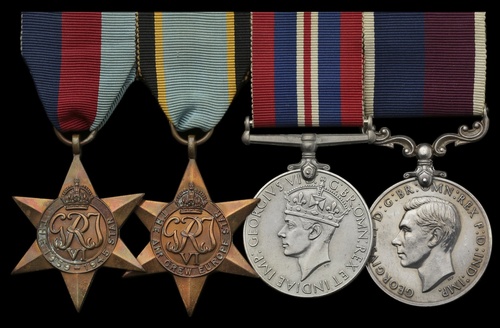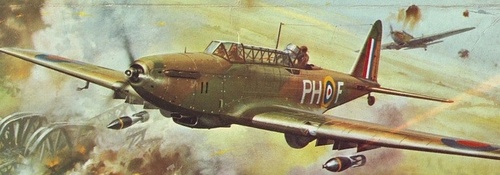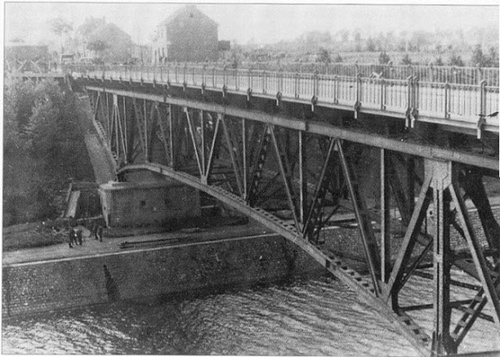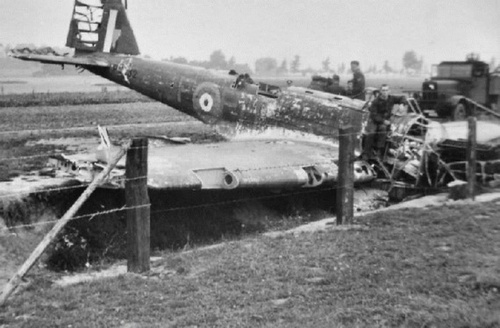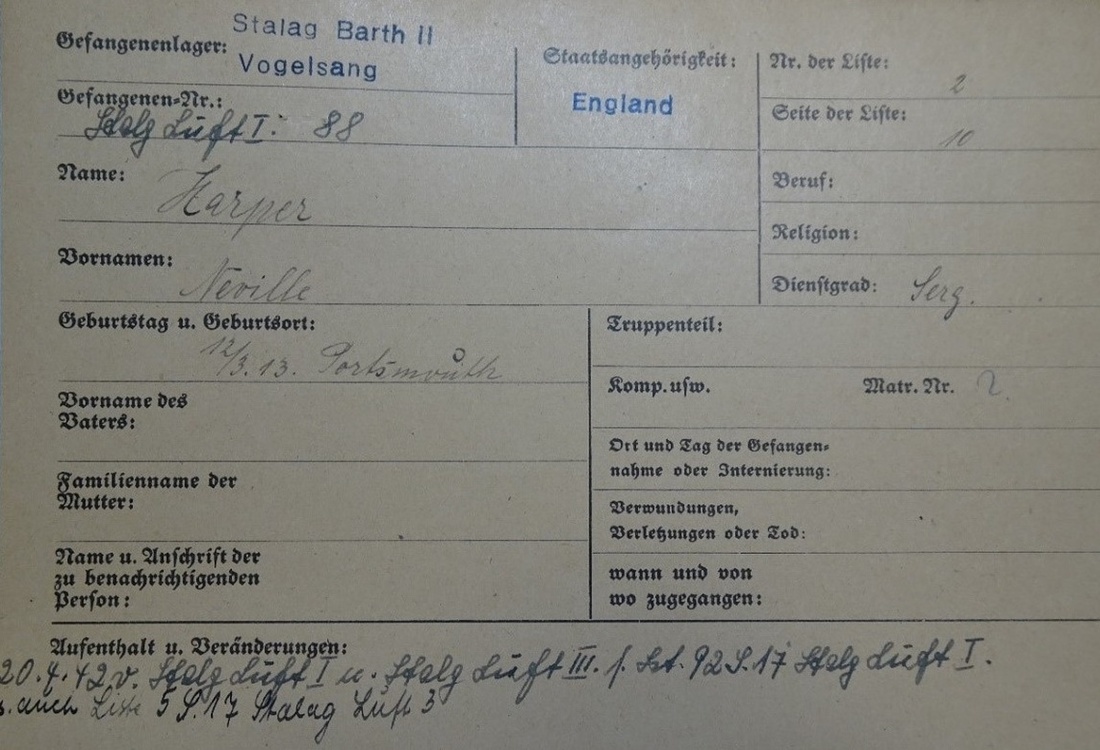Auction: 22003 - Orders, Decorations and Medals
Lot: 319
'Donald Garland, leading the second section, stayed below cloud base at 1,100 feet and on reaching the Veldwezelt area started a shallow bombing run through a veritable inferno of anti-aircraft fire - from an estimated 300 guns firmly entrenched in a defensive ring around the approaches to the bridge - only to be blasted to the ground. Behind him came Pilot Officer I. A. McIntosh (Battle L5439) who, before he could start his bombing run, had his main petrol tank hit by flak and the aircraft erupt in flames. Jettisoning his bomb load, McIntosh scraped a forced landing and survived, though a prisoner of war. The third Battle, L5227, piloted by Sergeant Fred Marland, plunged through the curtain of shellfire and released its bomb load but was then seen to head upwards in a wild, semi-controlled climb, wing over, and dive into the ground … '
Tragedy over Veldwezelt bridge on 12 May 1940; For Valour - The Air VCs, by Chaz Bowyer, refers.
An outstanding Second World War campaign group of four awarded to Warrant Officer N. T. W. Harper, Royal Air Force, who was an Observer in one of three Fairey Battles of No. 12 Squadron assigned to a suicidal attack on the Veldwezelt bridge in Belgium on 12 May 1940
Such had been the scale of losses suffered by Fairey Battle units at the outset of the Blitzkreig that Air Marshal A. S. Barrett ordered that No. 12's strike at Veldwezelt would have to be undertaken by volunteers
Approaching the target at low-level, in the face of shocking fire, all three aircraft were shot down, the section's sacrifice being recognised by the award of posthumous V.C.s to Flying Officer Donald Garland and his Observer Sergeant Thomas Gray
Harper's aircraft was hit in the main fuel tank and crash-landed - on fire - near Neerharen, but he, his pilot and gunner escaped the wreckage to be taken prisoners of war, thereby becoming the sole survivors of the attack
1939-45 Star; Air Crew Europe Star; War Medal 1939-45; Royal Air Force L.S. & G.C., G.VI.R., 1st issue (563534 W./O. N. T. W. Harper, R.A.F.), mounted as worn, good very fine (4)
Neville Thomas William Harper was born in Portsmouth on 12 March 1913, the son of Thomas Harper, a shipwright in the Royal Navy. His father was pensioned ashore in January 1922, following active service in the Great War, and his campaign medals and L.S. & G.C. Medal are included in the Lot.
Advanced Air Striking Force: suicide mission
Young Neville joined the Royal Air Force as an apprentice in August 1929 and, by the outbreak of hostilities, he was serving as an Observer on the strength of No. 12 Squadron, a Fairey Battle unit. The Squadron was quickly ordered to France as part of the Advanced Air Striking Force (A.A.S.F.), where Harper teamed-up as Observer to Pilot Officer I. A. McIntosh and Wireless Operator / Air Gunner Leading Aircraftsman R. P. MacNaughton in Fairey Battle L5439 PH-N. The 'Weapons and War' website sets the scene:
'The Fairey Battle was a single-engine light bomber. It was powered by the same Merlin engine that gave the Spitfire and Hurricane such great speed and performance, but, unlike the fighters, the Battle was weighed down by a three-man crew and an internal bomb load of four 250lb bombs. Although it had a rather sleek appearance, the Battle was 100 m.p.h. slower than the new generation of fighters entering service, was limited in range, lacked manoeuvrability and was extremely vulnerable to anti-aircraft fire from the ground. In the air, its defence consisted of a single machine-gun in the starboard wing and another mounted in the rear cockpit. In truth, the Battle was an obsolete aircraft, but had been retained by the R.A.F. at the outbreak of war as there was no adequate replacement at the time.
For the aircrew of 12 Squadron, the first eight months of the Second World War had proved relatively uneventful. Since being rushed to northern France at the outbreak of war as one of ten short-range bomber squadrons of the R.A.F.'s Advanced Air Striking Force, operations had been relatively few and far between and had been limited to a series of reconnaissance missions. The squadron had become settled at its grass airfield near the village of Amifontaine, some 25 miles north-west of Rheims.
Then, during the early hours of 10 May 1940, everything changed. The period that has since become known as the Phoney War came to a sudden and dramatic end as German forces attacked northern France and the Low Countries. The main German thrust had seen its armoured units cut-off and surround Allied units in Belgium and, in doing so, they had captured several vital bridges spanning the Albert Canal.
Two of these bridges were on the Dutch-Belgian border at Vroenhoven and Veldwezelt, on the western side of Maastricht. On the morning of 12 May, volunteers from 12 Squadron were called on to carry out a short-notice and high-priority raid. The volunteers that came forward had no idea of what the raid would involve and had been given no time to prepare; as the six crews made their way to briefing they were still coming to terms with the squadron's losses on the opening afternoon of the German offensive, just two days before, when three of the four Battles sent out to bomb enemy positions advancing through Luxembourg had failed to return.
As the volunteers listened to the briefing they soon realized they were facing a most daunting task. Their targets were two bridges at Maastricht, the ones at Vroenhoven and Veldwezelt, which had not been destroyed by retreating ground forces and were now allowing German forces to pour into Belgium. Tasked with leading a first section of three aircraft to attack the concrete bridge at Vroenhoven was Flying Officer Norman Thomas, while the second section, with the task of attacking the metal bridge at Veldwezelt, was to be led by a 21-year-old Irishman, Flying Officer Donald Garland … '
The same source continues:
'The second section, led by Garland, had taken off from Amifontaine just a few minutes after Thomas and Davy. The three Battles headed off towards their target at low-level beneath a layer of cloud. Garland's observer in 'PH-K', Sergeant Tom Gray, was one of seven brothers from Wiltshire and just a few days away from his twenty-sixth birthday. He had joined the RAF as an apprentice at the age of 15, and after leaving Halton had served as an engine fitter before volunteering for flying duties; this was to be his first bombing sortie of the war. Making up the crew was the Wireless Operator/Air Gunner, Leading Aircraftman Lawrence Reynolds, from Guildford in Surrey, who was just 20 years old.
Flying in Garland's section were Pilot Officer I. A. McIntosh in 'PH-N' [with Harper as his Observer] and 28-year-old Sergeant Fred Marland in 'PH-J'. By the time they could all see the bridge at Veldwezelt, the three Battles had already been spotted from the ground and a barrage of flak awaited them. Even before they could start their bombing run, McIntosh's aircraft had been hit in the main fuel tank and had burst into flames. Quickly jettisoning his bombs, McIntosh turned away and managed to make a forced landing near Neerharen to the south-east of Genk in Belgium. He and his two crew members, Sergeant N. T. W. Harper and Leading Aircraftman R. P. MacNaughton, were all captured.
Not wishing to hang around a moment longer than necessary, the two remaining Battles quickly commenced their attack. Without flinching, Garland and Marland flew head-on into the barrage of fire, seemingly ignoring the flak that greeted them. Despite the intensity of the anti-aircraft fire, Garland coolly led the two remaining Battles in a shallow dive-bombing attack on the bridge. After releasing his bombs, Garland's aircraft came under further attack, this time from the enemy fighters. Looking across to where the other Battle was making its attack, he witnessed Marland's aircraft suddenly pitch up, roll out of control and then dive into the ground near Veldwezelt; Marland, his Observer, 24-year-old Sergeant Ken Footner, and his Wireless Operator/Air Gunner, 22-year-old Leading Aircraftman John Perrin, were all killed.
Garland's bombs had hit the western end of the bridge, causing it some notable damage, but he now found he was in the most hopeless of situations. The Battle was no match for the 109s now swooping in numbers on their helpless prey, and was promptly shot down. The aircraft came down in the village of Lanaken, just 3 miles to the north of Veldwezelt; there were no survivors.
Of the fifteen crew members of the five Battles that had taken part in the raid, six were killed and seven were taken as prisoners of war. Although it was such a tragic loss, it is fortunate that one of the Hurricane pilots sent to sweep the area had witnessed the bravery of the Battle crews over the bridges at Maastricht, and he would later report the outstanding courage and determination displayed during the attacks despite such overwhelming opposition.
In the London Gazette of 11 June 1940, it was announced that Donald Garland and Thomas Gray were both to be posthumously awarded the Victoria Cross; the first R.A.F. V.C.s of the Second World War. Their citation concluded:
"Much of the success of this vital operation must be attributed to the formation leader, Flying Officer Garland, and to the coolness and resource of Sergeant Gray, who navigated Flying Officer Garland's aircraft under most difficult conditions in such a manner that the whole formation was able successfully to attack the target in spite of subsequent heavy losses."
Nearly a year later, Garland's mother attended the investiture ceremony at Buckingham Palace to receive the award to her son. She had four sons, but tragically they would all die while serving with the R.A.F. during the Second World War.'
Postscript
As cited above, Harper and his crew escaped the wreckage of their aircraft but, as related in an official report submitted by the Wireless Operator / Air Gunner - L.A.C. R. P. MacNaughton - he was badly burned:
'Flying Officer McIntosh (Australian) and Sergeant Harper (English) were badly burned and taken to hospital, originally in Masstricht. They reached Stalag Luft I, Barth, in the autumn of 1940. I last saw Flying Officer McIntosh in June or July 1942 and Sergeant Harper in October 1942, both at Stalag Luft 3, Sagan. I believe Sergeant Harper went to Stalag Luft 6.'
Harper was transferred from Stalag Luft 6 to Stalag 357 in the summer of 1944 and remained there until liberated in April 1945.
Subject to 20% VAT on Buyer’s Premium. For more information please view Terms and Conditions for Buyers.
Sold for
£1,800
Starting price
£1400

